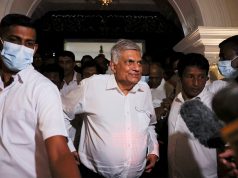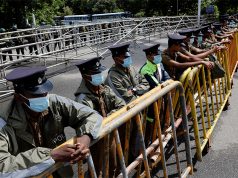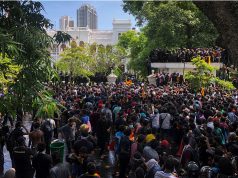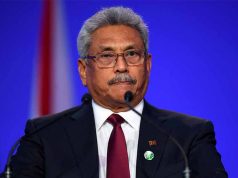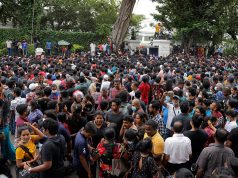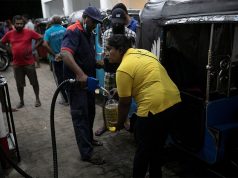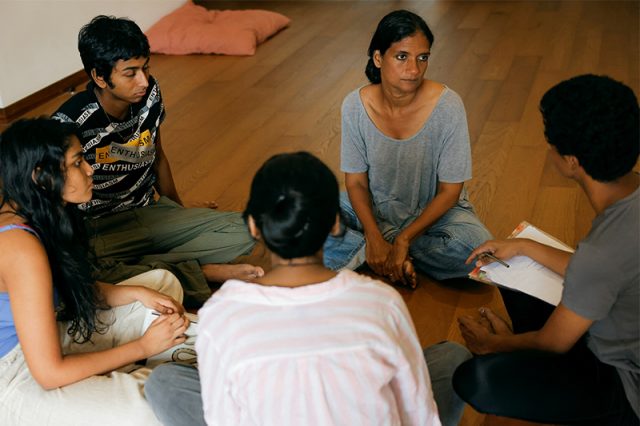
- Core group of activists rallied thousands to demonstrate
- The push revived a flagging nationwide protest movement
- Huge crowds descended on Colombo, occupied government buildings
- President, prime minister agree to resign after dramatic scenes
- Country in midst of unprecedented economic crisis
COLOMBO— In June, a few dozen activists started meeting regularly at a seaside tented camp in Colombo for hours-long sessions to think up ways to revive Sri Lanka’s flagging protest movement.
The group, which included a Catholic priest, a digital strategist and a popular playwright, succeeded beyond their wildest hopes.
Within weeks, hundreds of thousands of people descended on Colombo. After initially clashing with police, protesters occupied key government buildings and residences, forcing President Gotabaya Rajapaksa and his prime minister to promise to step down.
“I’m still trying to process it,” said Chameera Dedduwage, a digital strategist at a major advertising firm who became part of the team that helped organise the uprising.
“It was 50 percent premeditation and coordination, another 30 percent willingness of the people and 20 percent luck.”
In interviews, veterans of those small meetings described how they agreed on a multi-pronged campaign to inject new life into the movement widely known as “Aragalaya”, or “struggle” in Sinhala.
The movement had begun in March, when thousands took to the streets to vent their anger at lengthy power cuts and spiraling prices, and to call for the Rajapaksa family that had dominated the country’s politics for much of the last 20 years to leave power.
On May 9, Rajapaksa’s elder brother Mahinda – president from 2005-2015 and at that time serving as prime minister – had stepped down. On June 9, younger brother Basil had quit as a lawmaker.
So, the Aragalaya activists targeted July 9 as the day they hoped to unseat the president himself.
A plan emerged to combine online agitation, meetings with political parties, labor unions and student groups and door-to-door campaigning to get enough people back on the streets for a final push, according to the three attendees.
Public frustration at ongoing shortages, which has brought the economy to a standstill, and the president’s stubborn refusal to step aside, had been simmering for weeks.
Riding on trains, buses, lorries and bicycles, or simply walking, huge crowds converged on Colombo on Saturday, outnumbering security forces deployed to protect government buildings and upending Sri Lankan politics.
“Gota Go Home!” the crowds chanted in Colombo’s Fort area, seething over the country’s worst economic crisis since independence.
They quickly broke into the president’s colonial-era house, before storming a portion of the presidential office and entering the prime minister’s official residence 2.5 km (1.6 miles) away.
Rajapaksa and Prime Minister Ranil Wickremesinghe had been moved to undisclosed safe locations, and within hours they separately announced they would resign to allow an all-party interim government to take over.
If he resigns on Wednesday as promised, Rajapaksa, once a war hero who was both revered and feared, will become the first sitting Sri Lankan president to quit.
“I think it is the most unprecedented gathering in this country. Full stop,” Ruwanthie de Chickera, a playwright who is part of the core group of Aragalaya activists, told Reuters.
Representatives of the president and prime minister did not immediately respond to requests for comment on the protests and why they stepped aside. Their whereabouts have not been made public.
‘Everyone on board’
Sri Lanka has around 5 million households and 8 million active Facebook accounts, making online outreach an extremely effective way to reach demonstrators, said Dedduwage, the digital strategist.
“Which means basically through Facebook, we can practically reach every corner of the country at no cost,” Dedduwage told Reuters, sitting at a tent at “Gota Go Village”, the main Colombo protest site that mockingly refers to the president.
In early July, one of those who received the group’s social media messages was Sathya Charith Amaratunge, a marketing professional living in Moratuwa, some 20 km from Colombo, who had taken part in earlier anti-government protests.
The 35-year-old took a poster he received via WhatsApp on July 2 that read “The Country to Colombo, July 9” in Sinhala, and uploaded it on his personal Facebook page.
That night he began preparing a campaign that would eventually see tens of thousands of people join him on a march to Colombo.
Other Aragalaya members reached out directly to opposition political parties, trade unions and student unions, including the influential Inter University Students’ Federation (IUSF), in order to bolster support, according to Dedduwage.
One of Sri Lanka’s largest student groups, the IUSF has a reputation for its political agitation and clashed with security forces during recent protests, dismantling police barricades amid teargas and water cannon.
The Aragalaya group also asked volunteers to visit thousands of homes across parts of Colombo, including middle-class government housing estates, some within walking distance of the main protest site.
To bring people in from outside the city, activists appealed to more than 30 “Gota Go Village” sites that had sprung up in towns and cities across the country.
Late on July 8, police declared a curfew in several districts around Colombo, which activists said was aimed at stalling the planned protest. Police said the move was to maintain public order. Some core group members swiftly moved to safe houses, fearing arrest.
Jeevanth Peiris, a Catholic priest who is part of the activist group, worried that only a few thousand people would turn up the next day because of the restrictions. Fuel shortages had curtailed transport options for weeks.
“We honestly expected only 10,000 with all these restrictions, all this intimidation,” he told Reuters, dressed in a white cassock. “We thought 5,000 to 10,000.”
‘People didn’t want to give up’
Early on July 9, marketing professional Amaratunge said he started off on foot from Moratuwa with around 2,000 fellow protesters, about the size of group he had expected after a week of sharing posts on Facebook and WhatsApp.
It was only when he left his hometown that Amaratunge said he realised how many people wanted to go to Colombo. Many had been angered by the curfew, which the police withdrew early on Saturday.
In multiple Facebook livestreams posted by Amaratunge on Saturday, several hundred people can be seen strolling down the main road to Colombo, some holding the national flag.
By Amaratunge’s estimate, tens of thousands eventually joined the march he was on, and reached Colombo’s fort area. According to a police official who spoke on condition of anonymity, the crowd there swelled to at least 200,000 people.
Members of the Aragalaya core group said several times that number took part, as wave upon wave of people arrived in Colombo and marched towards the main protest site.
Organizers had roughly calculated that it would take around 10,000 people to overpower personnel guarding each of the four entry points to the president’s house, Dedduwage said.
In the early afternoon, after dismantling police barricades and commandeering water cannon, protesters took apart the tall gates guarding the president’s house and overwhelmed a large deployment of security forces.
By night, Rajapaksa and Wickremesinghe’s official residences were occupied by protesters, who uprooted fences outside the presidential secretariat and took over a part of it. Wickremesinghe’s personal residence was attacked and a section of it set alight.
Within hours, the leaders were ready to go.
“There were so many elderly, teenagers, youth, women,” recalled Peiris, the priest, who said he was part of clashes with police.
“People didn’t want to give up, didn’t want to withdraw.”
—Reporting by Devjyot Ghoshal and Uditha Jayasinghe; Editing by Mike Collett-White and Peter Graff




